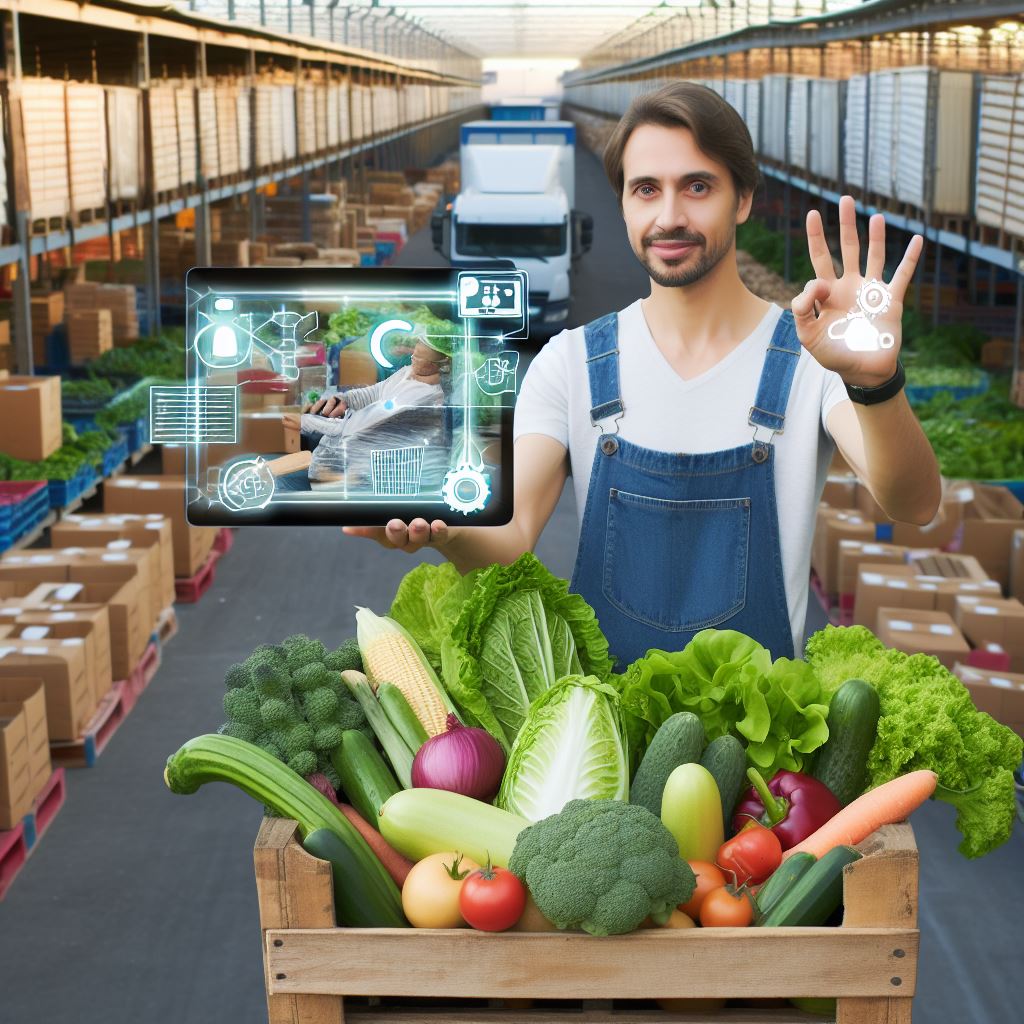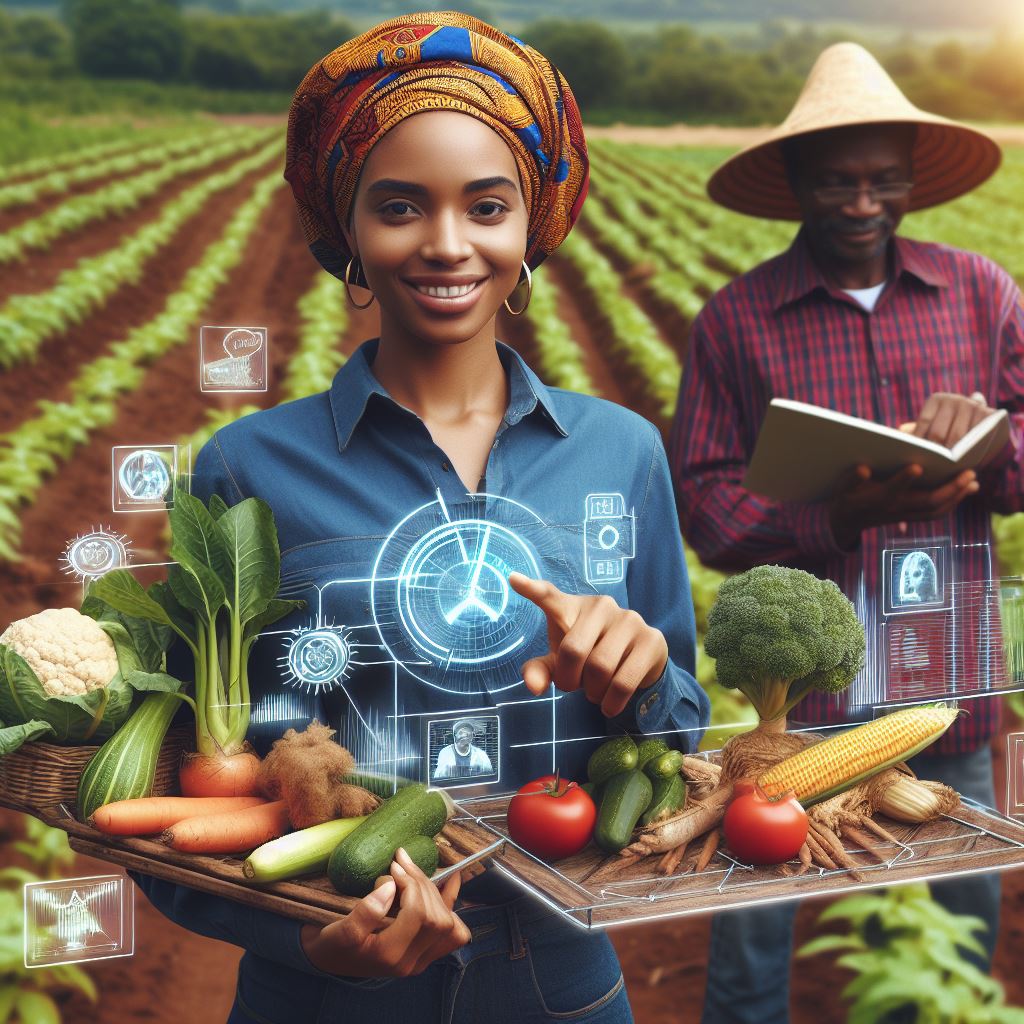Introduction
Let’s explore Agri Supply Chains IoT Solutions.
In recent years, the agricultural industry has witnessed a transformative shift with the advent of IoT solutions.
These innovative technologies have revolutionized traditional farming practices by introducing real-time data monitoring, automation, and enhanced connectivity throughout the supply chain.
IoT devices such as sensors, drones, and smart machinery are being deployed across farms to collect valuable data on soil health, weather conditions, crop growth, and livestock monitoring.
This data is then analyzed to optimize farming operations, improve resource efficiency, and enhance productivity.
From field to fork, IoT solutions offer unprecedented visibility and control over every stage of the agricultural supply chain, enabling farmers to make data-driven decisions and respond promptly to changing conditions.
In this blog section, we will explore the impact of IoT solutions on agri supply chains, examining their benefits, challenges, and the potential for future advancements in optimizing agricultural production and sustainability.
Overview of agri supply chains
Define agri supply chains and explain their role in the agricultural industry
Agri supply chains play a crucial role in the agricultural industry by ensuring the smooth flow of goods from farm to fork.
These supply chains encompass all the steps involved in the production, processing, and distribution of agricultural products.
The agri supply chain begins with the farmers who grow the crops or raise livestock.
From there, the products are typically transported to processing facilities where they undergo various stages of transformation.
After processing, the goods are distributed to wholesalers, retailers, and finally reach the end consumer.
Challenges faced by agri supply chains
Agri supply chains face inefficiencies, impacting costs and delays throughout production and distribution stages.
Quality control challenges arise from weather conditions, pests, and diseases affecting product consistency.
Traditional systems lack real-time data, hindering decision-making and timely interventions.
Transform Your Agribusiness
Unlock your farm's potential with expert advice tailored to your needs. Get actionable steps that drive real results.
Get StartedPoor traceability complicates safety measures and regulatory compliance in agri supply chains.
Inaccurate demand forecasting leads to overstocking or stockouts, causing financial losses.
IoT integrates sensors and software to collect and analyze real-time data, enhancing supply chain performance.
Sensors monitor environmental conditions for optimal growing conditions, improving agility.
Real-time data enables proactive decision-making based on demand fluctuations, reducing inventory risks.
IoT enhances traceability, tracking product movement and ensuring quick identification of issues.
Quality control systems monitor freshness and composition, improving customer satisfaction and reducing waste.
IoT solutions revolutionize agri supply chains, addressing inefficiencies, quality control, traceability, and demand forecasting challenges.
Embracing IoT is crucial for agri supply chains to remain competitive, sustainable, and meet global food demand.
Read: Green Supply Chain: The Future of Farming
Explanation of IoT solutions
Provide an overview of IoT (Internet of Things) and its application in various sectors
IoT, also known as the Internet of Things, is a revolutionary concept in technology that has taken various sectors by storm.
It involves connecting everyday devices and objects to the internet, allowing them to collect and exchange data.
With the power of IoT, industries have been able to improve efficiency, automation, and productivity in numerous ways.
One sector that can greatly benefit from IoT solutions is the agricultural supply chain.
By implementing IoT devices and solutions, farmers and distributors can overcome many challenges and enhance the overall efficiency of their operations.
How IoT solutions can be implemented in agri supply chains
One-way IoT solutions can be implemented in agri supply chains is through the use of sensors.
These sensors can be installed in fields, equipment, and storage facilities to monitor and collect data on various variables such as temperature, humidity, soil moisture, and crop growth.
This data can then be analyzed to make informed decisions about irrigation, fertilization, and pest control, leading to improved crop yield and quality.
In addition to sensors, IoT can also be used to optimize logistics and transportation in the agricultural supply chain.
By equipping vehicles, such as trucks and drones, with IoT devices, real-time tracking and monitoring of goods can be achieved.
This enables farmers and distributors to have complete visibility of the movement of their products, ensuring timely delivery and reducing the risk of spoilage or damage.
Highlighting the benefits of using IoT solutions in terms of improved efficiency, transparency, and visibility in the supply chain
Implementing IoT solutions in the agri supply chain brings several benefits.
Firstly, it enhances efficiency by automating processes and reducing manual tasks.
For example, instead of manually checking soil moisture levels, IoT sensors can continuously monitor and adjust irrigation systems, saving time and resources.
Showcase Your Farming Business
Publish your professional farming services profile on our blog for a one-time fee of $200 and reach a dedicated audience of farmers and agribusiness owners.
Publish Your ProfileIn terms of transparency, IoT solutions provide real-time data that can be accessed by various stakeholders in the supply chain.
Farmers can track the growth and condition of their crops, distributors can monitor the transportation and storage of goods, and consumers can have visibility into the origin and quality of the products they purchase.
This transparency promotes trust and accountability throughout the supply chain.
Furthermore, IoT solutions improve visibility in the agri supply chain.
By having access to accurate and up-to-date data, farmers and distributors can identify bottlenecks, inefficiencies, and areas for improvement.
They can make data-driven decisions to optimize processes, reduce waste, and increase overall productivity.
In general, IoT solutions have the potential to revolutionize agri supply chains.
By implementing sensors and IoT devices, farmers and distributors can monitor and optimize various aspects of their operations, leading to improved efficiency, transparency, and visibility.
As technology continues to advance, it is crucial for the agricultural industry to embrace IoT and harness its transformative power to ensure a sustainable and resilient supply chain.
Read: Mastering Farm Budgets: 2024 Edition
Impact on Agri Supply Chains
In today’s advanced technological landscape, the Internet of Things (IoT) solutions have revolutionized various industries, including agriculture.
The implementation of IoT in agri supply chains has significantly improved traceability and tracking of agricultural products, ensured quality and freshness through environmental monitoring, and optimized supply chain processes through predictive analytics.
Improved Traceability and Tracking
IoT solutions have provided a whole new level of traceability and tracking in agri supply chains.
By incorporating sensor devices and RFID tags into packaging and containers, it becomes easier to track the movement of agricultural products throughout the supply chain.
- Real-time tracking enables stakeholders to pinpoint the exact location of products, minimizing delays and enabling efficient logistics management.
- Access to accurate and up-to-date data regarding product movements allows for improved transparency and quality control.
- IoT devices also enable the recording of crucial information such as temperature, humidity, and handling conditions, ensuring that products meet required standards.
Agricultural producers, suppliers, and retailers can now have better control and visibility of their products, leading to reduced losses and improved customer satisfaction.
Environmental Monitoring for Quality and Freshness
IoT sensors play a vital role in monitoring and maintaining the optimal environmental conditions during transportation, thus ensuring the freshness and quality of agricultural products.
- Temperature and humidity sensors can detect any deviations from the ideal conditions and alert stakeholders, helping them take corrective actions promptly.
- Monitoring environmental conditions also allows for better preservation of perishable goods, reducing spoilage and increasing shelf life.
- By maintaining the required environmental parameters, IoT solutions ensure that consumers receive high-quality agricultural products that meet their expectations.
The ability to track and monitor environmental conditions in real-time has significantly reduced post-harvest losses and enhanced the overall efficiency of agri supply chains.
Potential for Predictive Analytics in Supply Chain Optimization
IoT solutions also present a tremendous potential for leveraging predictive analytics to optimize supply chain processes, reduce waste, and increase productivity.
- By analyzing vast amounts of data collected from various sensors, predictive analytics can forecast demand patterns and optimize inventory management.
- Accurate demand predictions can facilitate efficient production planning, reducing overproduction and minimizing waste.
- Predictive analytics can also help identify potential bottlenecks in the supply chain, allowing for proactive measures to be taken to prevent disruptions.
Furthermore, by integrating IoT with other technologies such as artificial intelligence, machine learning, and blockchain, supply chains can become even more efficient, secure, and transparent.
Therefore, the adoption of IoT solutions has had a significant impact on agri supply chains.
Improved traceability and tracking, environmental monitoring for quality and freshness, and the potential for predictive analytics have revolutionized the way agricultural products are managed, transported, and distributed.
By harnessing the power of IoT, stakeholders in the agricultural industry can optimize their processes, minimize waste, and meet the ever-increasing consumer demands for high-quality produce.
Read: Farm Finance: Securing Loans & Grants

Challenges and Considerations
Implementing IoT solutions in agri supply chains brings several potential challenges and limitations that need to be addressed.
These challenges include cost, infrastructure, and data privacy concerns.
Address potential challenges and limitations of implementing IoT solutions in agri supply
Cost
- Implementing IoT solutions can involve significant costs, especially for small and medium-sized farmers.
- Purchasing and installing IoT devices, sensors, and network connectivity can impose a financial burden.
- Regular maintenance, software updates, and data management also contribute to the overall cost of IoT implementations.
Infrastructure
- IoT solutions rely on a robust and reliable infrastructure to collect and transmit data in real-time.
- In remote or rural areas where agriculture is prevalent, the lack of proper network coverage can hinder IoT implementation.
- Investments in improving network infrastructure, such as expanding coverage or implementing rural broadband, may be necessary.
Data Privacy Concerns
- The collection, storage, and analysis of immense amounts of data in IoT solutions raise significant data privacy concerns.
- Agricultural data, including sensitive information about crop yields, weather conditions, and farming practices, must be adequately protected.
- IoT solutions need to comply with relevant data protection regulations to ensure the privacy and security of farmers’ and consumers’ data.
In addition to these challenges, the need for standardized protocols and interoperability for IoT devices across different stakeholders in the supply chain is vital.
Discuss the need for standardized protocols and interoperability for IoT devices across different stakeholders in the supply chain
Standardized Protocols
- IoT devices from various manufacturers often use different communication protocols.
- Without standardized protocols, interoperability between devices becomes complex, hindering data exchange and collaboration.
- Standardized protocols enable seamless integration and communication between different IoT devices and systems.
Interoperability
- Effective IoT solutions in agri supply chains require interoperability between devices used by farmers, distributors, processors, and retailers.
- Data needs to flow seamlessly across different stages of the supply chain, enabling real-time insights and decision-making.
- Interoperability ensures that data collected from field sensors, weather stations, and mobile applications can be utilized by all stakeholders.
Standardized protocols and interoperability enhance the efficiency, transparency, and traceability of agri supply chains.
Generally, while implementing IoT solutions in agri supply chains offers numerous benefits, challenges and considerations must be taken into account.
The costs, infrastructure requirements, and data privacy concerns need to be addressed effectively.
Furthermore, the need for standardized protocols and interoperability is crucial for seamless data exchange and collaboration between stakeholders.
By overcoming these challenges and incorporating IoT solutions, the agri supply chains can become more efficient, sustainable, and resilient.
Read: Navigating 2024 Agri-Financial Waters
Case Studies
Providing real-life examples of agri supply chains that have successfully implemented IoT solutions
Jensen Farms used IoT solutions to monitor temperature and humidity levels in their potato storage facilities.
The implementation helped them identify potential issues and reduce crop loss by 30%.
Real-time data analysis allowed for quick decision-making and improved storage conditions.
Cargill, a global food corporation, implemented IoT sensors in their grain silos to monitor inventory levels.
This IoT solution streamlined inventory management and reduced overstocking and shortages.
Real-time data analytics improved supply chain visibility, enabling efficient planning and cost savings.
INOX used IoT sensors in their cryogenic tanks to monitor the storage and transportation of liquid nitrogen.
Real-time monitoring enhanced safety by detecting leaks or abnormal temperature variations.
Showcase Your Farming Business
Publish your professional farming services profile on our blog for a one-time fee of $200 and reach a dedicated audience of farmers and agribusiness owners.
Publish Your ProfileIoT solutions reduced manual inspections, saving time and improving operational efficiency.
GreenCo, a lettuce supplier, implemented IoT-enabled soil sensors to monitor moisture levels in their fields.
Accurate data analysis optimized irrigation, resulting in a 20% reduction in water consumption.
IoT solutions enabled proactive pest control, minimizing crop damage and increasing yield.
The specific benefits and outcomes achieved by these implementations
- Increased efficiency: IoT solutions automate data collection and analysis, reducing manual labor and errors.
- Improved forecasting: Real-time data enables precise demand forecasting, reducing stockouts and wastage.
- Enhanced quality control: IoT sensors monitor key parameters, ensuring optimal storage and transportation conditions.
- Cost savings: IoT solutions optimize processes, reducing energy consumption, inventory costs, and crop losses.
- Supply chain transparency: Real-time tracking and monitoring provide visibility and traceability throughout the chain.
- Improved decision-making: Data insights from IoT solutions empower stakeholders to make informed choices.
- Risk mitigation: IoT-enabled alerts and notifications help detect anomalies and prevent supply chain disruptions.
- Sustainable practices: IoT solutions optimize resource usage, promoting environmentally friendly approaches.
- Customer satisfaction: Timely deliveries and higher product quality enhance customer experience and loyalty.
Ultimately, the implementation of IoT solutions in agriculture supply chains has proven to be highly beneficial.
Real-life case studies demonstrate how IoT technologies can improve efficiency, reduce costs, enhance quality, and promote sustainable practices.
With the continued advancement of IoT, these benefits will only increase, making it an essential tool for modern agri supply chains.
Conclusion
Summarize the main points discussed in the blog post
The implementation of IoT solutions in agri supply chains has shown significant positive impacts.
The use of IoT has improved efficiency by providing real-time data and insights, enabling better decision-making and reducing waste.
Quality control has also been enhanced through the use of IoT sensors to monitor temperature, humidity, and other factors that affect product quality.
Additionally, IoT solutions have contributed to sustainability by optimizing resource usage, reducing environmental impact, and enabling precision agriculture practices.
Emphasizing the positive impact of IoT solutions on agri supply chains, including improved efficiency, quality control, and sustainability
The positive impact of IoT solutions on agri supply chains is undeniable, and this technology should be further explored and adopted in the agricultural industry.
The potential benefits are vast, ranging from increased productivity and profitability to better product traceability and consumer trust.
It is crucial for stakeholders in the agricultural industry to consider and invest in IoT solutions to stay competitive and meet the growing demands of a globalized market.
By embracing IoT, agri supply chains can become more resilient, efficient, and sustainable, ultimately benefiting both producers and consumers.
Encouraging further exploration and adoption of IoT solutions in the agricultural industry
To fully unlock the potential of IoT in agri supply chains, collaboration between technology providers, farmers, and other stakeholders is essential.
It is crucial to develop tailored solutions that address specific challenges and requirements of different segments within the agricultural industry.
Moreover, awareness and education about the benefits and best practices of IoT adoption should be promoted to encourage widespread implementation.
The future of agri supply chains lies in the integration of IoT technology, and it is exciting to witness the transformative power it brings to the industry.




